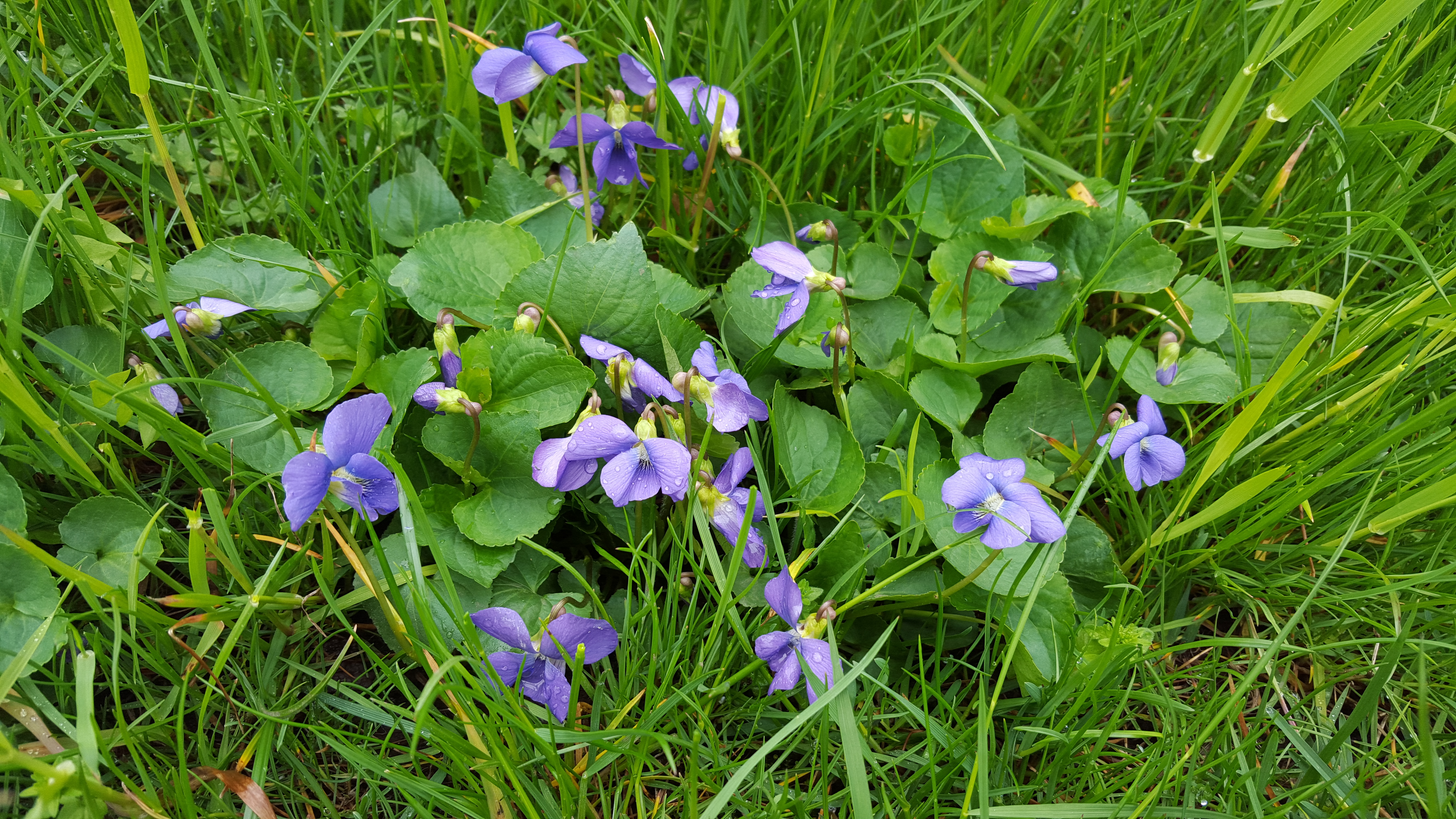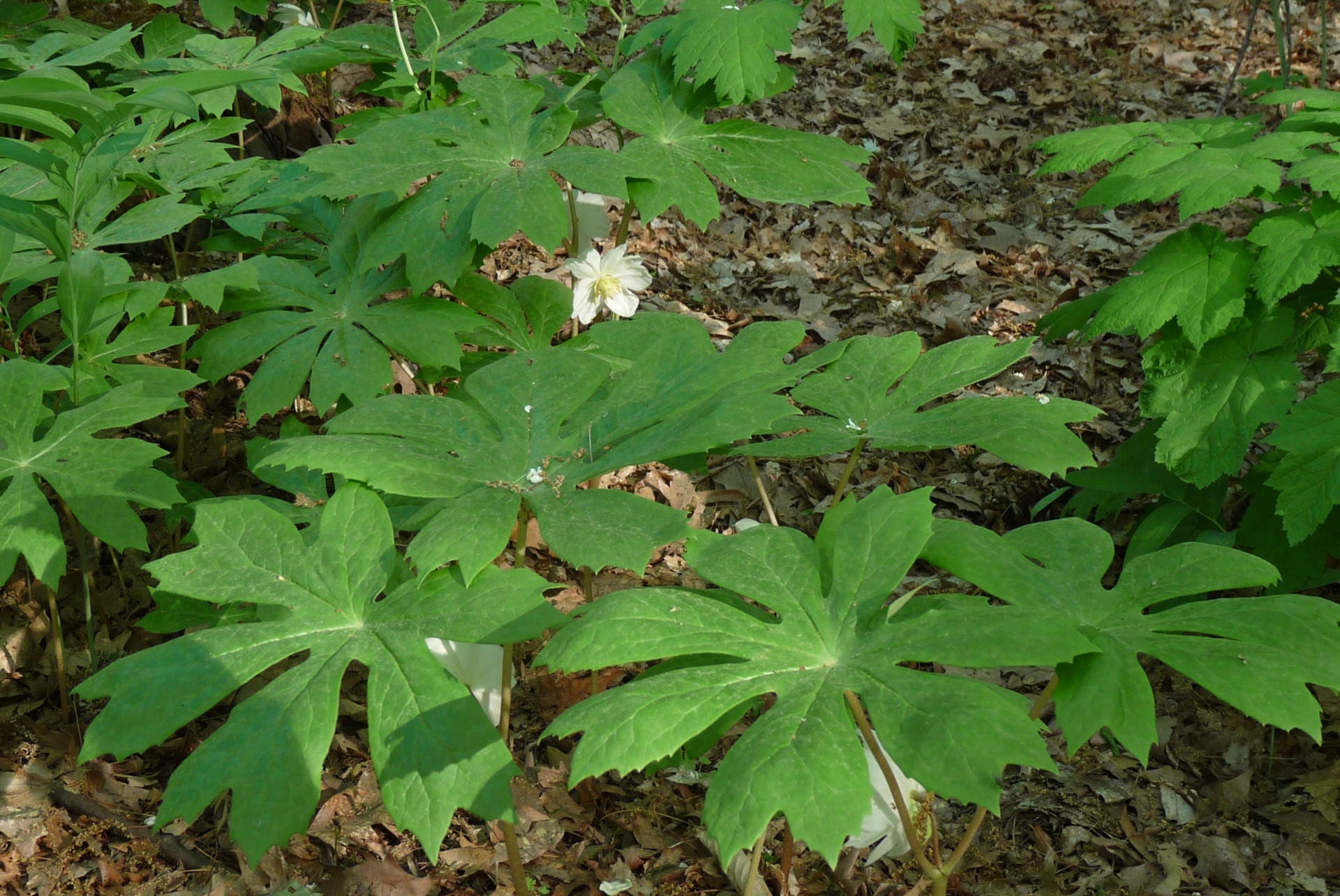by Georgia Hann and Russ Cohen
There are many reasons to plant native plants in our landscapes, including to increase support for pollinators and beneficial insects, to boost resources for birds and other wildlife, and to stabilize habitats despite environmental and climatic changes. When the native plant species a landowner chooses to add to the landscape also feature human edibility, an additional layer of excitement and engagement is sparked. Not only do these indigenous gems offer the sensory indulgence of new flavors and textures to enjoy and discover, but they also offer a deeper level of food security. Plants adapted to the variable climate of the Northeast are generally more drought-tolerant than the average Western agriculture crop and tend to thrive well in the acidic soils commonplace in New England. Having spanned centuries of coevolution, native flora have also developed myriad symbioses with regional biota which help to guard them against pests and diseases.

When May apple (Podophyllum peltatum) foliage fades in August, the plant’s fully ripened fruit can be consumed raw or cooked into jam or a compote. Photo: Russ Cohen
The bright and savory essences of harvestable native flora broaden our taste palettes during times of abundance, providing depth and interest to an already-full plate, but can also serve as important supplemental food sources during times of leanness and scrimping. While a spattering of native edible plants sprinkled throughout one yard in a neighborhood may provide too small a harvest to feed the whole county, they nevertheless provide a valuable means of diversifying one’s diet. The resource of native plants can grow to become a greater asset: whatever the harvest yields, be it fruits, blossoms, nuts, roots, or otherwise, be sure to consider the future while filling your harvest-basket and leave behind roots and seeds for the plant to spread, whether by your hands, squirrels’ paws, or the mouths of birds. Most plants produce hundreds or thousands of seeds, and by learning to propagate seed-grown native plants yourself, you can help these fruitful beings spread into your local vicinity with a greater density.
The plant profiles to follow include notes on plant culture and propagation techniques, as well as general descriptions and consumption tips. If you decide to purchase starter plants at a nursery or plant sale (see the footnotes at the end of this article for a link to suggested retailers1), we suggest avoiding cultivars2 and opting instead for “straight-species3” plants that have been grown in your ecoregion4 from local, responsibly-harvested seed without the use of harmful neonicotinoides5.
Basswood (Tilia americana)
This handsome tree can reach 60 feet or more in height at maturity. While people in cities may be more familiar with basswood’s European cousin, the little-leaf linden (Tilia cordata), commonly deployed as a street tree, the native basswood (aka American linden) is more commonly encountered in the countryside, where it may be typically found alongside farm fields or other forest edges, and in river and stream floodplains. Basswood leaves are distinctly asymmetrical (lopsided) and are shiny when first emerging in the spring. They can then be eaten raw or cooked and have a bland flavor and slightly mucilaginous texture. Other, and arguably more highly regarded, edible parts of the plant are the flower blossoms, which arrive at the onset of summer and make a tasty tea with multiple medicinal values. Each flower cluster consists of about 6-10 yellowish-white flowers that give off a pleasant, lemon-honey fragrance. Attached to each flower stem is a curved bract, which aids in dispersal of the ripe seed in the fall. (It is not necessary to remove the bract when making tea from the flowers.) Tea brewed from the fresh or dried flowers has a very pleasant taste, and is said to have a calming effect on both the mind and the digestive system. Last but not least, a basswood tree in full bloom is exceedingly popular with bees and other pollinators, so much so that, upon approach a tree can be heard before it is seen. While basswood trees can be propagated by seed, it is considered to be somewhat difficult to do so. Zones 3-8.

Tilia americana in bloom with edible flowers. Photo courtesy of Robert Smith and the Lady Bird Johnson Wildflower Center
Black chokeberry (Aronia melanocarpa)
Black chokeberry is a medium-large deciduous shrub that grows 2-10 feet in height with toothed, shiny, simple, alternate, dark green leaves. Clusters of delicate five-petaled white flowers later become clusters of small blue-black berries that have a pearly luster and are round with a distinctive pucker in lieu of a persistent calyx. The berries can be eaten raw for a refreshingly bitter and astringent effect, or can be made into a sweet juice or jam. Touted for their health-promoting qualities due to their high levels of the antioxidant anthocyanin pigments, the fruits can also be made into a medicinal syrup or tea. More decadently, they can be used in baked goods or as a flavoring for yogurt, ice cream, or custard. Variable adaptability allows this plant to survive in wet areas as well as dry areas, edges, and transition zones with very poor soil. Black chokeberry prefers full sun in neutral to acidic soils. Fruits ripen in late August and can be harvested through early-mid September. While it can be propagated by seed, it is also readily available in nurseries. Zones 3-9.
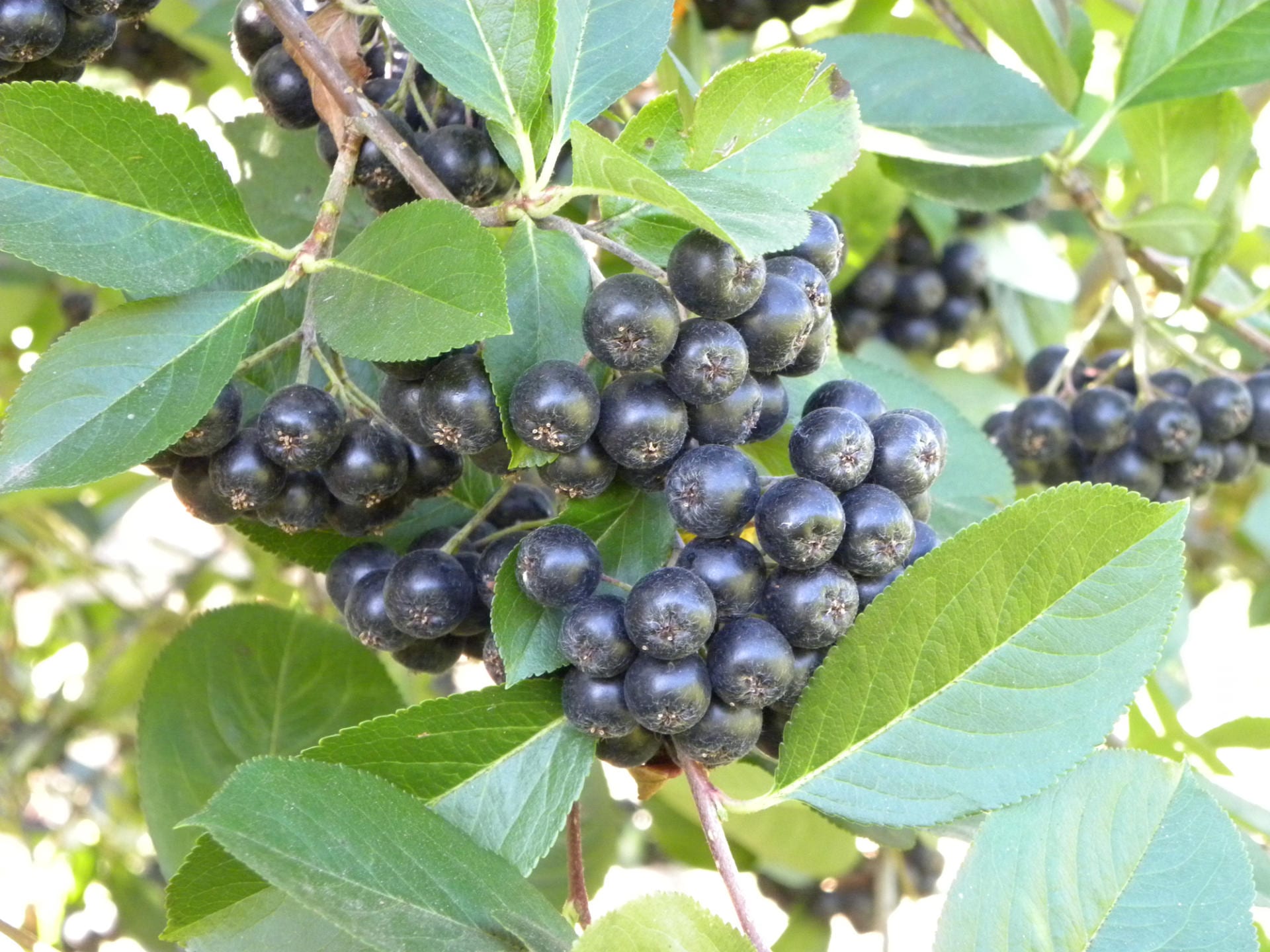
A medium-sized shrub, black chokeberry (Aronia melanocarpa) produces clusters of delicate white flowers, which are followed by berries that can be delicious added to baked goods.
Broadleaf cattail (Typha latifolia)
This obligate wetland species is always found in or close to water, usually around ponds, slow-moving rivers, and swamps. If you have a backyard water feature, this is an easy plant to cultivate at the water’s edge. If your cattail patch subsequently threatens to spread beyond where you want it to grow, you may be able to control it to some extent by harvesting and eating it. Broadleaf cattail has long, grass-like leaves that are round at the base and extend straight up from the stalk, which is green but woody at maturity. The stalks yield the broadleaf cattail’s recognizable seedhead: a brown structure reminiscent of a corndog. Broadleaf cattail shoots should be collected in the springtime while they’re still tender. Flower heads should be harvested while still green. Rhizomes can be collected in late fall and winter, though be aware that mature rhizomes will be unpalatably fibrous whereas young rhizome tips will be delectably smooth. The tender shoots can be eaten raw or lightly cooked, while the rhizomes can be cooked or stored as a dry flour. Flower pollen can be sieved and used as a flour additive, lending a golden hue to baked goods. The immature male flower heads can be grilled and eaten like corn on the cob, or steamed and consumed straight through to the core. (You can read more about this plant in Chapter Six of Russ’ foraging book, Wild Plants I Have Known…and Eaten.) Zones 3-10.
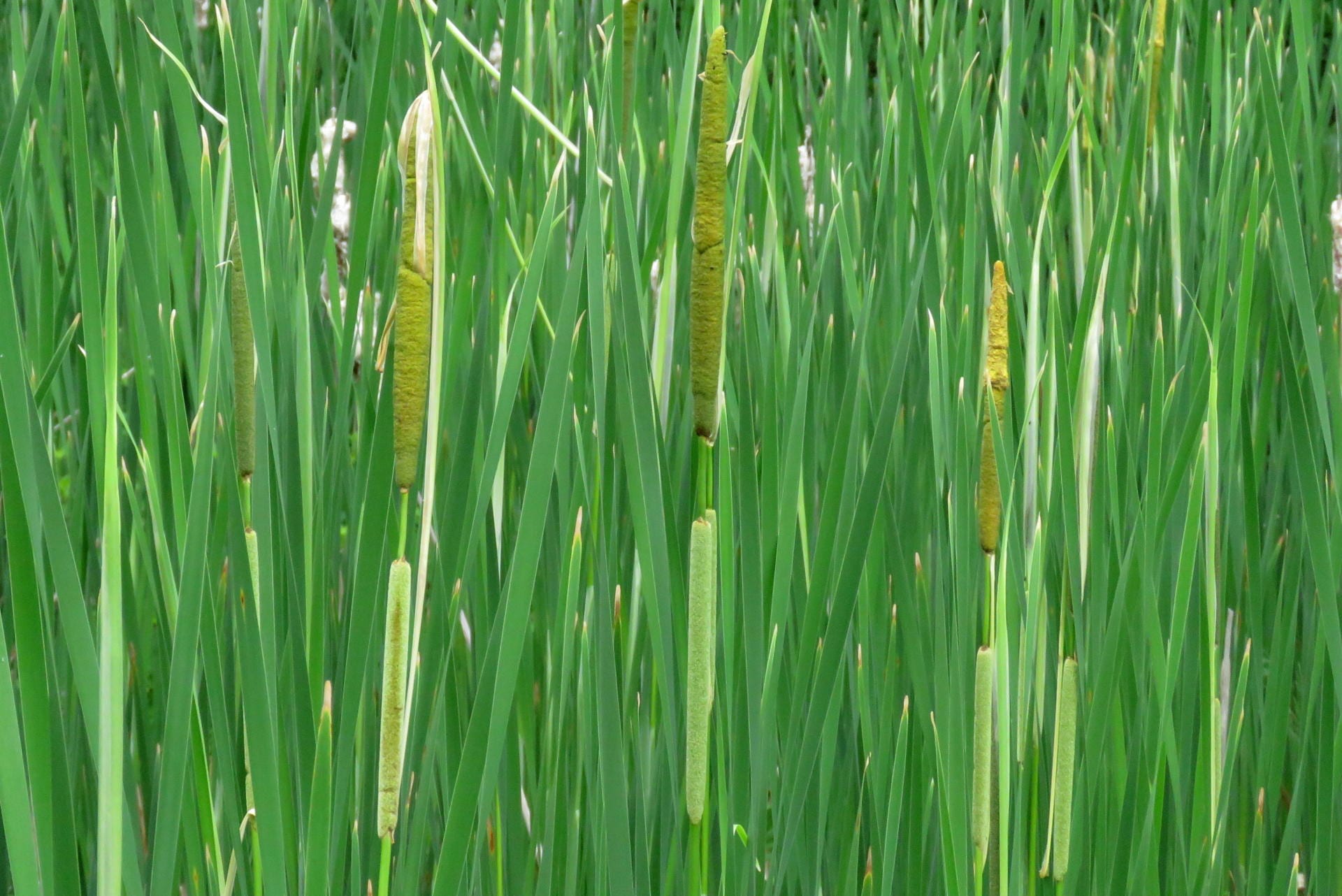
Broadleaf cattail enhances a backyard water feature, plus tender shoots, flower heads, and rhizomes are all edible. Photo: Josh Fecteau
Dooryard violet (Viola sororia)
This is the species in the Viola genus one is most likely to encounter in a natural (untreated) lawn and in dappled to full sun near areas of human habitation (hence the common name). This is also the member of the genus we most recommend for eating, as other Viola species may be rare (and protected) and/or have a laxative effect. Just look for the purple flowers and the relatively large, shiny, heart-shaped leaves. Like wild strawberry (see below), dooryard violet plants do not mind being mowed or stepped on, so they make an excellent addition to a lawn (if they aren’t already there). Dooryard violet flowers are edible raw and are a pretty addition to salads. They can also be candied by being dipped into a beaten egg white, then into superfine sugar, and then set aside to dry. Dooryard violet leaves are also edible, raw or cooked, until the flowers disappear; then the leaves become tough and bitter. By weight, violet leaves have more Vitamin A than carrots and more Vitamin C than oranges. While it is possible to propagate Viola sororia from seed, a simpler way to obtain plants would be to dig a few up (with permission, of course) from a large population, and then re-plant in an appropriate location. Dooryard violets have a rhizome-like root and are easily transplantable. Zones 3-7.
Orange-flowered jewelweed (Impatiens capensis)
This tender annual usually reaches 2 to 4 feet in height with rounded-toothed, muted blue-green alternate leaves. Rarely found on its own, it tends to form dense stands in moist areas, often along water bodies, and in low-lying, damp woodland areas with moderate shade. The green center stalk is juicy, crisp, and smooth, while the branching side stalks are comparatively limp with a purplish-pink tint. Orange-flowered jewelweed’s small (1- to 1.5-inch-long) trumpet-shaped flowers are a sunny orange color with dense reddish-maroon freckles speckled on the front faces of the petals. A closely related species, yellow-flowered jewelweed (Impatiens pallida), exhibits pale yellow flowers but is otherwise visually synonymous, and shares common uses and habitat preferences with orange-flowered jewelweed. Pod-shaped green seed capsules are 0.5- to 1-inch-long and explode at maturity, bursting open to expel seeds when touched (hence the plant’s alternative common name, “touch-me-not”). The seed capsules mature from late summer into early fall, and the football-shaped, walnut-flavored seeds within can be captured by cupping a hand or two around a capsule and gently pulling it away from the stem as it bursts open; these nutty morsels can be eaten alone or scattered on salads or other dishes.
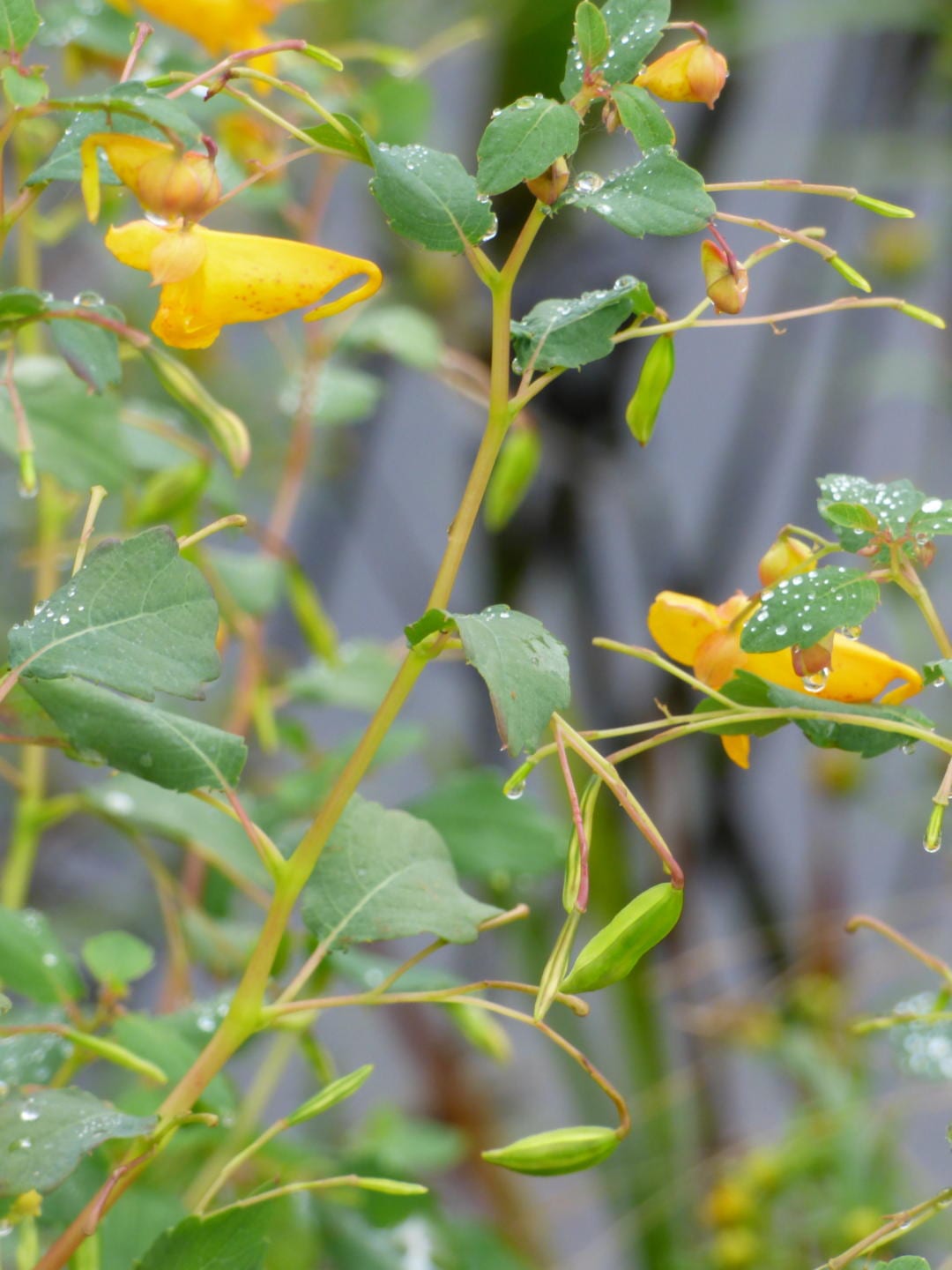
Also known as “touch-me-not,” orange-flowered jewelweed produces ripe seed pods that burst open when touched. Photo: Russ Cohen
Another fun aspect of this plant is the fact that if you gently rub the outer covering off a mature orange-flowered jewelweed seed, you’ll discover that the seed itself is colored a bright, robin’s egg blue. Some harvest the plants’ stems and leaves for consumption as well (the younger spring shoots will be more appealing in texture and flavor), but for safety these parts of the plant should be boiled for 15 minutes before eating, changing out the cooking water twice during the process. Further, this part of the plant should not be eaten in excess (or by individuals particularly prone to the development of kidney stones) due to a high concentration of calcium oxalate crystals. Nonetheless the distinctive orange flowers and fun popping seed capsules make this plant a delightful feature for a damp residential landscape. And a bonus: the juice exuded from the crushed leaves and stems of orange-flowered jewelweed offer skin-soothing properties that can help ease bug bites and may prevent poison ivy if applied shortly after exposure. Jewelweed is a prolific self-sower, so expect it to persist where you have planted it. Zones 2-11.
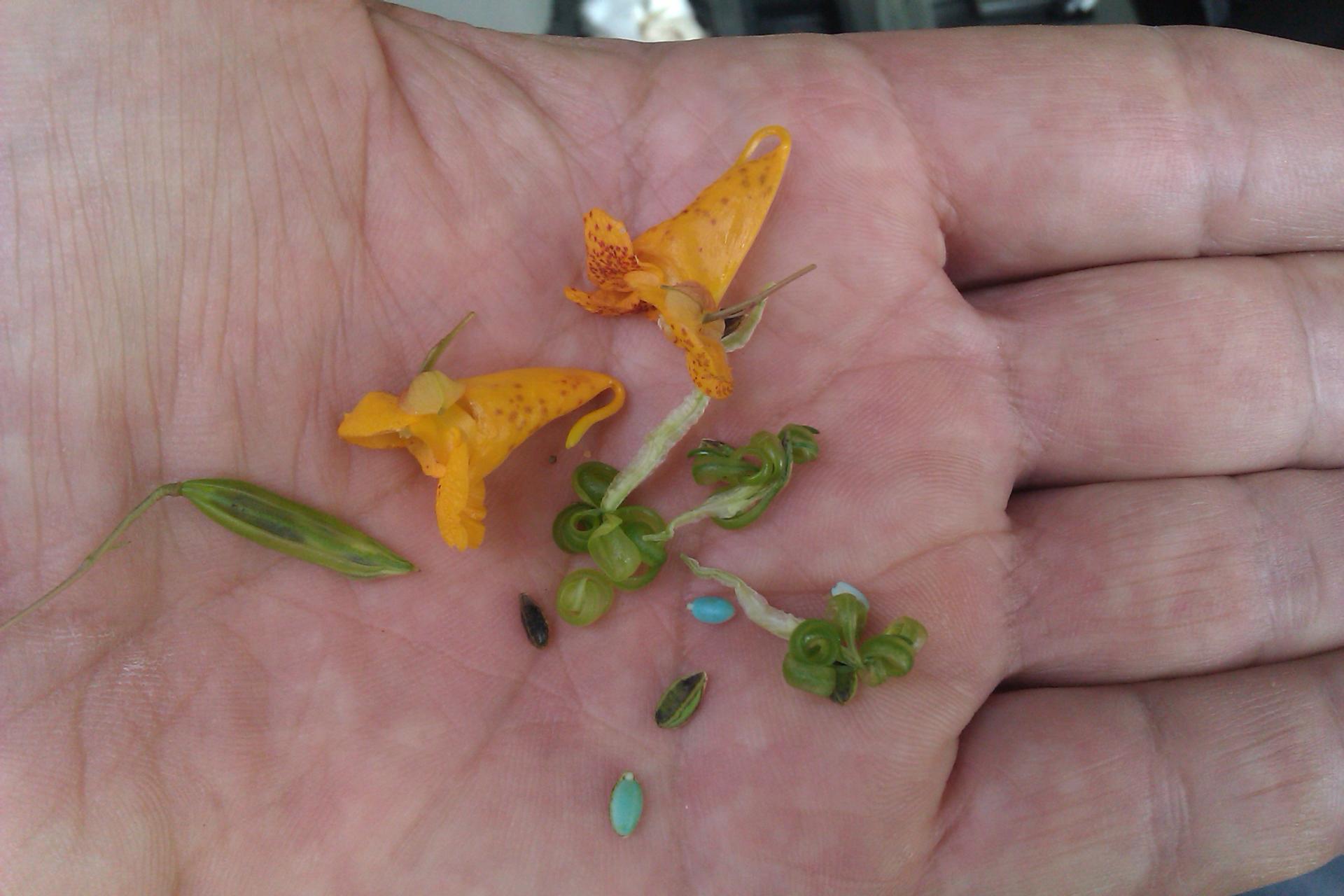
Jewelweed flowers, ripe seed pod, exploded seed pod, ripe seed and peeled ripe seeds. Photo: Russ Cohen
May apple (Podophyllum peltatum)
May apples are an excellent plant choice for shady spots (especially under hardwoods), where the soil is damp, but not wet, and high in organic matter. The plants emerge relatively early in the spring. Shiny umbrella-shaped leaves measuring up to a foot across top single or crotched stems 12 to 18 inches tall. Only the forked-stem plants will produce flowers, which are large, fragrant, waxy, white-petaled, and emerge in May (hence the species’ name). Although all other parts of this species are poisonous, the fully ripe fruit is delicious, oozing with a tropical flavor reminiscent of guava. The large egg-shaped berry, 1 to 2 inches in diameter, is ripe when it turns a deep yellow color and is soft and slightly wrinkly to the touch. May apple leaves senesce (droop and turn brown) shortly before the fruit is ripe in late August or early September. It is edible raw (though, again, must be completely ripened) or cooked, in which case it can make a lovely jam or compote. Box turtles (Terrapene carolina) are also fond of May apple fruit and assist in seed dispersal. The plant also spreads vegetatively via its stout rhizomes, so plan accordingly when deploying it in the landscape; it is apt to spread beyond its initial area of cultivation. Zones 4-8.
Eastern native roses (Rosa spp.)
Cumulatively, Eastern native roses are a versatile group well-suited to occupy a variety of habitat types. The 3- to 4-foot-high shrubs have opposite, toothed, thin compound leaves on prickled stems. With upland species that are optimal for hillsides and meadows, plus lowland types that are more suitable in woodlands or swamps, and a wide margin of habitat adaptability across species, this genus is a fabulous choice for the home landscape. And that’s without mentioning the gorgeous flowers, timeless floral aroma, and suitability for pollinators!
To enjoy the bliss of roses on yet another level, try placing a fresh rose petal in your mouth. Pressed against the surface of your tongue, the unmistakable essence of rose will permeate your senses. The delicate petals can be decadently arranged as a garnish on room-temperature dishes, which will be cool enough to prevent wilting or fading. Petals are available for harvest in early summer and, dried, may be preserved and used in tea blends. Remember, the showy petals of the rose flower are a flag to pollinators searching for nectar. Be certain to leave plenty behind on the plant so each rose can continue to communicate, visually, to other beings that it is ripe for pollination and has plenty of nectar to offer.
The rosehips, smooth and sometimes studded with bristly hairs, ripen to a tomato-red or deep-pink color. They can be harvested beginning in late summer to early fall and often persist into the winter even after a frost, which makes them an important food for wildlife. A remarkable source of vitamin C, rosehip flesh can be eaten (sans seeds and skin) raw or used to make jellies and jams. Dried rosehips can be ground into a vitamin- and mineral-rich powder that can be sprinkled into smoothies or onto oatmeal. The following five species are New England’s native roses, and all of them are good choices for the home landscape (and could even be deployed as thorny hedges to help deter unwanted visitors).
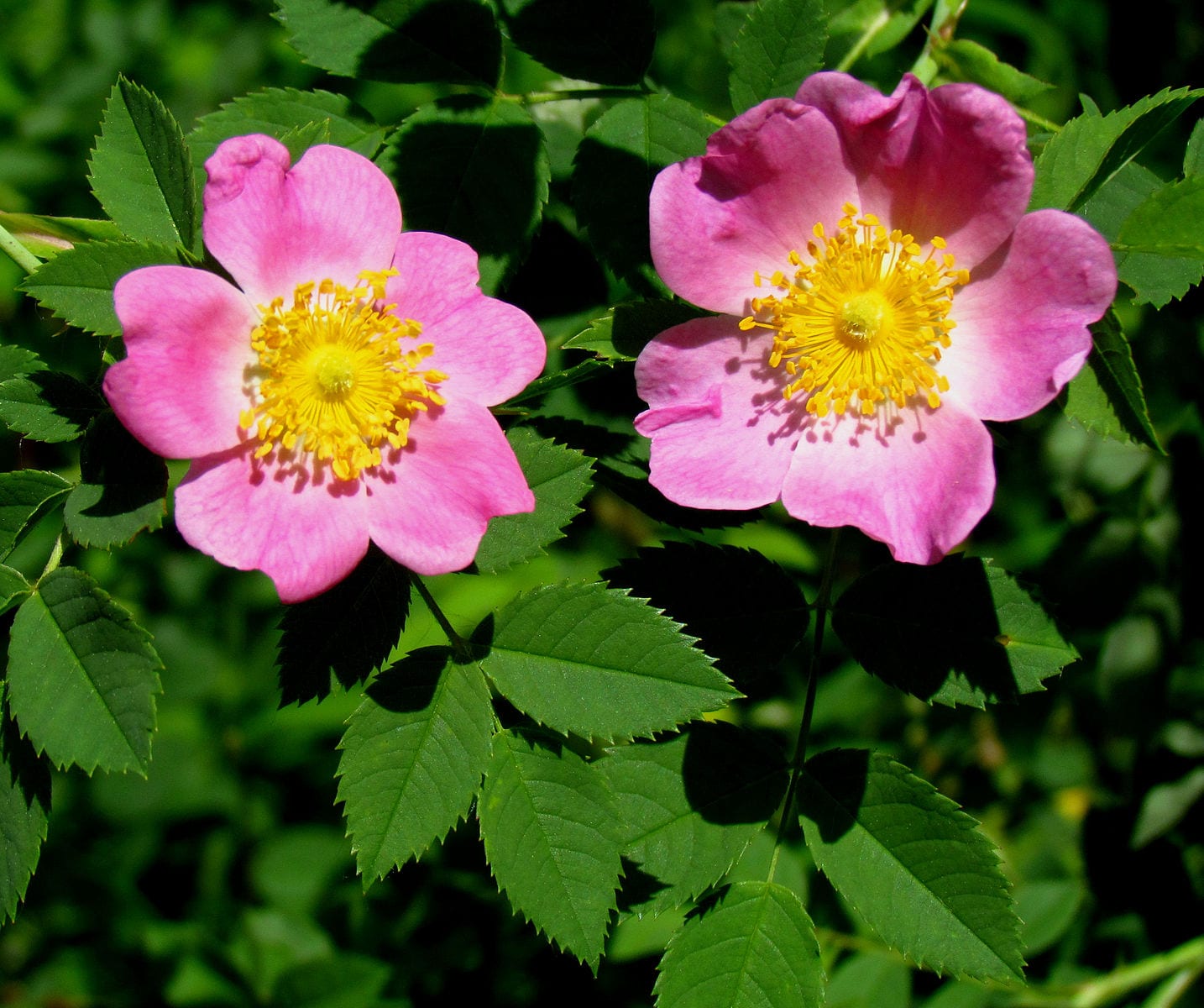
Carolina or pasture rose is one of several roses native to the East coast that is worthy of inclusion in the built landscape as a food source for wildlife and humans. Photo: D. Gordon E. Robertson
Carolina rose (Rosa carolina)
This shrub, also known as pasture rose, is well-suited to uplands like hillsides and high meadows in full sun. Nonetheless, it can occasionally be found in damper, lower areas. Carolina rose is common throughout the eastern United States up through Canada. The five-petaled flowers are a sweet, pale, pink-purple color. Zones 4-8.
Swamp rose (Rosa palustris)
As the name implies, this species does well in damp, acidic conditions. It is more tolerant of shade than Carolina rose or Virginia rose, which makes it a good candidate for wet forest borders and in areas of dappled sun. Swamp rose is abundant in the eastern half of the United States up through Canada. Its petals are a light rosy hue. Zones 3-8.
Virginia rose (Rosa virginiana)
This tough species is a good candidate for sandy, dry areas with a lot of sun exposure. It can even tolerate some salt, so it is a great choice along the coastline or even towards the edge of a roadside property that receives modest salt deposits during winter snow treatments. It bears five-petaled, pale pink flowers and is found in the northeast corner of the United States, up through Canada. Zones 3-8.
Shining rose (Rosa nitida)
This rose is listed as a species of special concern in Connecticut. It is a northern species with a southern range reaching into northern Connecticut and southern Massachusetts. With magenta flowers, the shrub is showy and prefers wet, acidic areas like bogs and damp thickets. It could be a lovely plant along a wet residential border mulched with leaves from deciduous trees and sheltered by the neighboring plants of a greater landscape and/or a stone wall. Zones 4-7.
Smooth rose (Rosa blanda)
Smooth rose is versatile, thriving on slopes, along riversides, at forest margins, and in meadows. It thrives in the northern central and eastern United States, up through Canada. Unlike the other Eastern native roses, its stems are nearly prickle-less; this may make it a popular choice for the landscape. Zones 3-6.
Ostrich fern (Matteuccia struthiopteris)
This species is New England’s only native fern to produce an edible fiddlehead that is safe to eat in quantity. (The native Bracken fern, Pteridum aquilinum, is also edible, but reputedly carcinogenic if eaten in large amounts.) Ostrich fern thrives in dark, moist, wooded areas; along streams; in alluvial floodplains along large rivers; and in shaded roadside gullies. The young fiddleheads emerge in vase-shaped clumps in early spring and can be distinguished from other non-edible fiddleheads by two main characteristics. First, the ostrich fern has a pronounced groove (like that of a celery stalk) that runs along the inside of the slightly bluish stem. Second, the top of each fiddlehead (the curled-up part, called a crozier) is encased in a papery brown covering that sheds off very easily to reveal completely smooth fiddleheads within. The window of collection-time for ostrich fern fiddleheads is mid-April to early May, before the fronds unroll into elegant leaves that reach up to 5 feet in length. Each fiddlehead can be cut or snapped off at the base where the stalk meets the ground; the entire stem can be consumed. We strongly recommend limiting your harvesting to one or two fiddleheads per clump to avoid threatening the health of the plant. To render them safely palatable, ostrich fern fiddleheads should be boiled for at least five minutes before eating or incorporating into different dishes. With a deep, rich, green flavor, ostrich fern fiddleheads are delicious on their own or with modest seasonings of oil and garlic, but they also work well in omelets and stir-fries. Zones 3-7.
Starry false Solomon’s seal (Maianthemum stellatum)
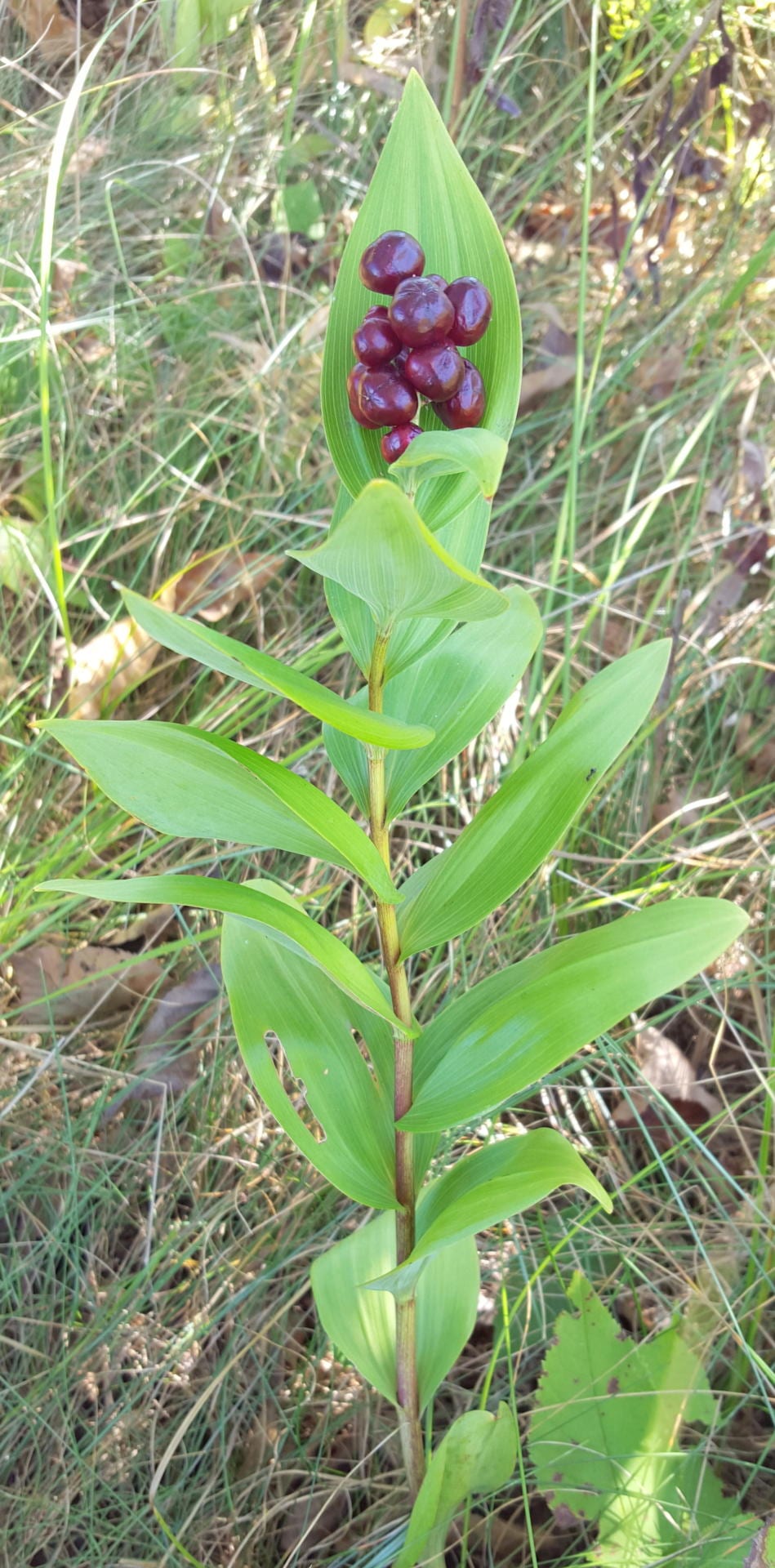
Young shoots and ripe fruits of starry false Solomon’s seal (Maianthemum stellatum) are edible. Photo: Russ Cohen
This rhizomatous perennial is usually found growing in sandy woodland soils, along water bodies, in forest gaps, and in fields; it appears to be especially abundant within a few miles of the Atlantic coastline. A close relative of the more commonly-encountered false Solomon’s seal (Maianthemum racemosum), Starry false Solomon’s seal is arguably more landscape-worthy, as its flowers and berries are larger than those of its cousin. The young shoots (boiled or steamed until tender) and ripe fruits (raw or cooked) of both species are edible. The flavor of the ripe fruit resembles cranberry sauce sweetened with molasses. Be aware, though, that the berries of both species may have a laxative effect if consumed in large quantities – a trait they share in common with another related edible native plant called twisted stalk (Streptopus lanceolatus), otherwise known as “scoot-berry.” Each of these species can be propagated by seed, although the seeds are hydrophilic (they must be kept moist) and need to be stratified to break their dormancy. Alternatively, they can be simply sown in the fall after ripening, but might take two to three years to germinate. Zones 3-7.
Sweet goldenrod (Solidago odora)
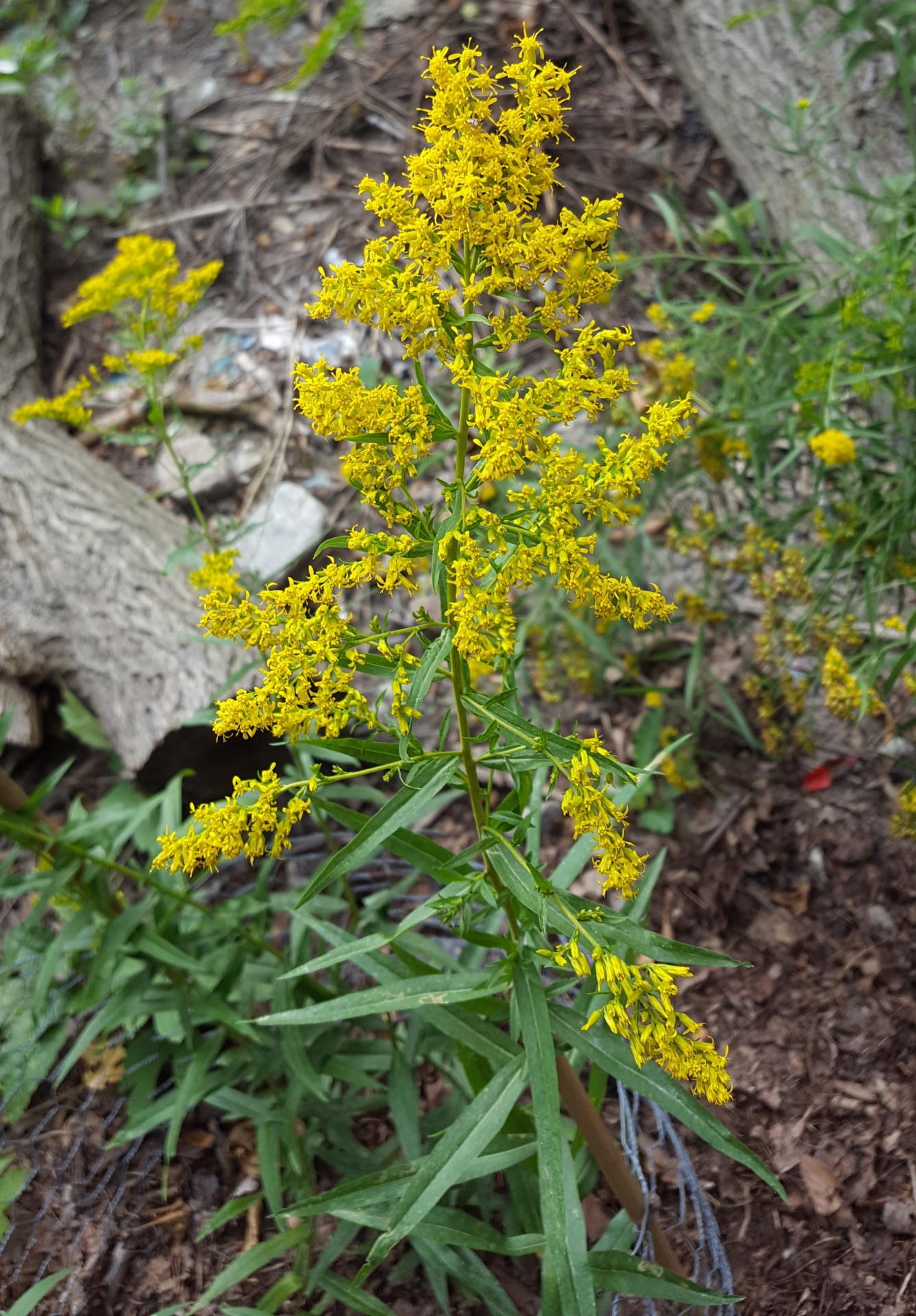
Dried leaves and flowers of sweet goldenrod make a delicate licorice-flavored tea. Photo: Elizabeth Wylde
Unlike some other members of the Solidago genus, which can spread aggressively in the landscape, Solidago odora is a slow spreader and tends to occur in smallish clumps 1 to 3 feet in diameter, thereby leaving plenty of room in the landscape for other plants sharing similar habitat preferences. Sweet goldenrod can tolerate dry conditions, such as found on rocky outcroppings or sandy barrier beaches. It can be distinguished from most of its kin by the smooth (untoothed) margins of its leaves, and perhaps even more so by the anise-scented aroma given off by the crushed leaves and flowers. The leaves make an excellent tea with a delicate licorice flavor. Sweet goldenrod is exceedingly easy to grow from seeds, which need no stratification or other pre-treatment. It can be sown outdoors any time during the growing season, and indoors at any time of year. If the plant does not get big enough to flower the first year, it certainly should by the second. Zones 4-10.
Tupelo (Nyssa sylvatica)
Also known as black gum, tupelo is a species with a large range, extending northward from the Gulf of Mexico into southern New England and some lower elevations in northern New England. Tupelo’s natural habitat is wooded freshwater wetlands, including those quite close to the ocean. Perhaps the most well-known edible product associated with the tupelo tree is tupelo honey, which is produced in the species’ southeastern range. Less well-known is the fact that tupelo bears edible fruit. The fleshy, egg-shaped drupes are colored a dull, dark blue, and each one is about the size of a small jellybean. It is the thin layer of very sour pulp surrounding the seed that is edible. Fruit may be nibbled straight off the tree. With patience, one could possibly collect enough tupelo fruits to make some sort of a tart sauce or jelly. Tupelo tree leaves typically turn a spectacular shiny red in the fall. Twigs and branches regularly attach at nearly perpendicular angles – an attractive feature that is also helpful for identification. Tupelo can be propagated by seed and either sown after ripening in the fall, or stored in a plastic bag in the fridge and sown the following year. It is important to protect flats sown with tupelo and similar larger-sized seeds (like spicebush: Lindera benzoin) from marauding rodents, who will happily (and quickly) dig up an entire flat, even after the seeds have sprouted into seedling trees. Zones 4-9.
Wild leek (Allium tricoccum)
Also known as “ramps” in the culinary community, wild leeks can still be found in large patches when encountered in the woods, unless the area has been depleted by unscrupulous over-harvesting. The species thrives in damp, rich, wooded areas beneath dense deciduous forest canopies. Each young wild leek plant has a pair of garlic-scented linear green leaves with parallel venation and pointed tips; leaves connect to a stalk that is usually pinkish-purple, turning to white as it forms the underground bulb. The ephemeral Allium tricoccum leaves emerge quite quickly in the early spring, but turn yellow and fade away as the forest leafs out. The plant has a “second act,” though; the leaves give way to maroon-tipped scapes that later become spherical clusters of white flowers, followed by the formation of seeds which are shiny and black when ripe. While some people like to harvest (i.e., dig up) entire plants, bulbs included, this is not necessary, as the leaves are delicious in and of themselves. We recommend a more sustainable, “no-dig” method of harvesting this species. Confine your picking to just one leaf per plant; leave the remaining leaf attached to the bulb and leave the bulb in the ground. Limiting your harvest to one leaf per plant will help the patch to thrive into the future. It is wise to leave a good portion of a wild leek patch completely untouched; this help maintain the vigor of the group as a whole. With a superb taste that is slightly spicy and emits a chive-like flavor, wild leek leaves are delicious eaten raw, briefly wilted in butter and sherry, muddled into fresh pesto or dip, boiled in soups and stews, or sprinkled as a flavorful garnish on salads and other dishes. While wild leeks can be propagated by seed, it takes at least five years for seed-grown plants to achieve harvestable size. Zones 3-8.
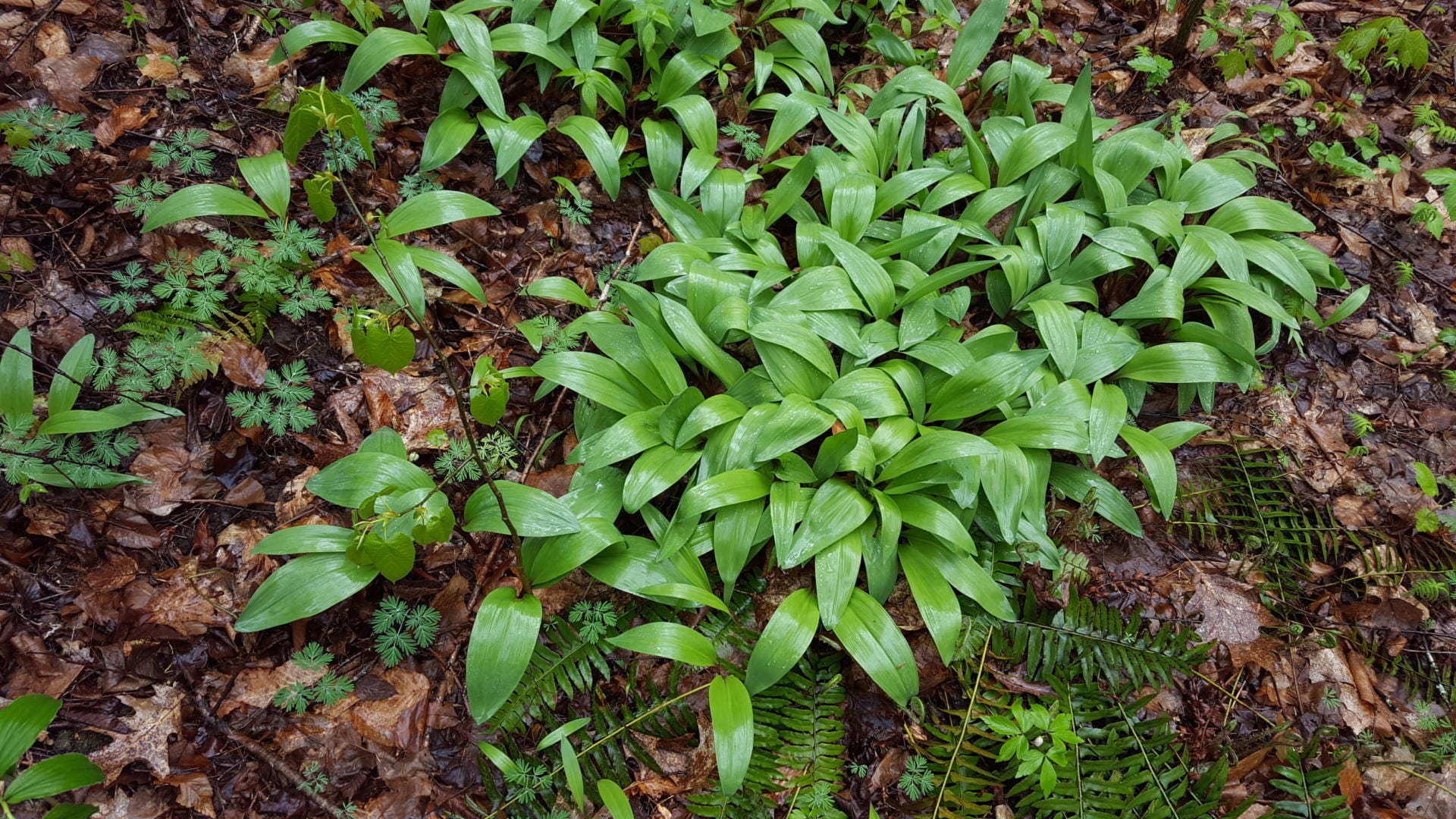
While challenging, propagating wild leeks (ramps) from seed rewards the gardener with an early spring treat. Judicious harvesting will ensure the plants’ continuation into the future.
Wild strawberry (Fragaria virginiana)
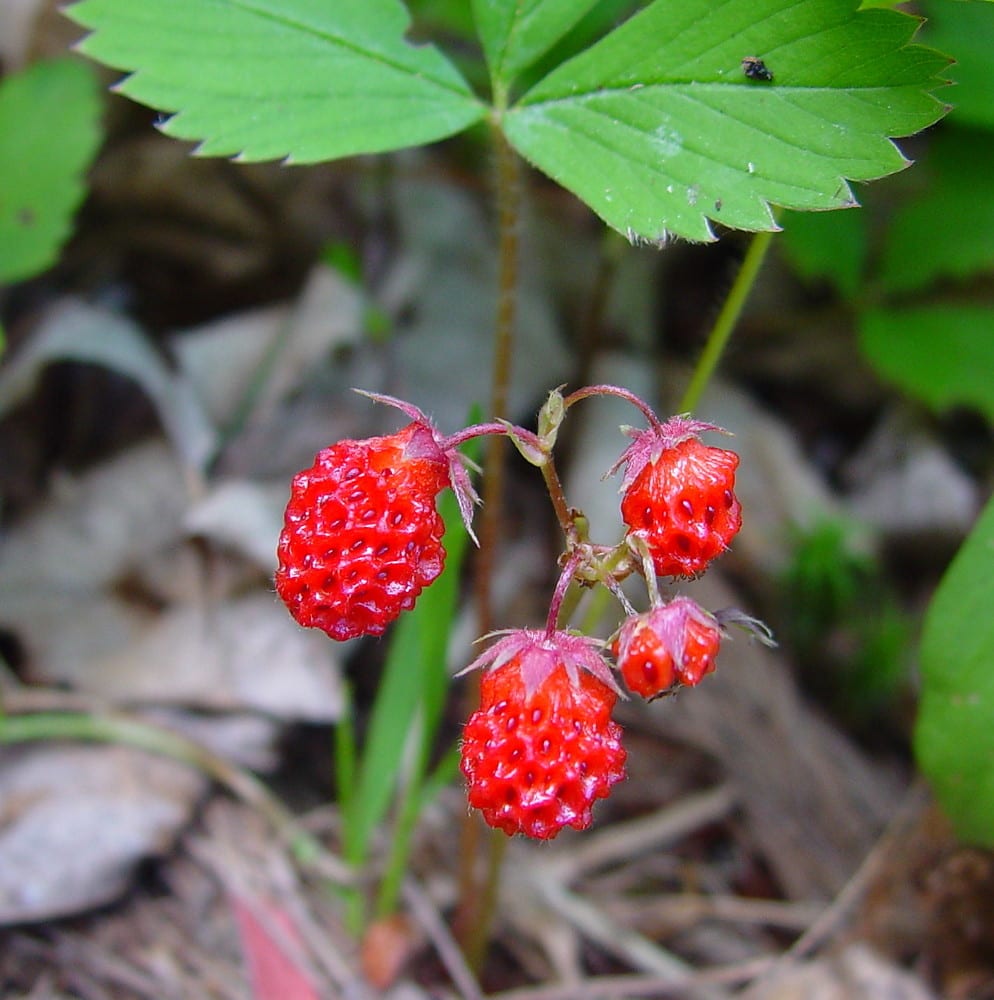
Smaller than its cultivated cousin, wild strawberry is a tough and tasty alternative or additive to lawns. Photo: Arthur Haines
Just about everyone has some spot that can accommodate wild strawberries. These diminutive plants do not mind getting mowed or stepped on, so they are a great ground cover, lawn alternative, or lawn supplement that can do very well in sunny spots where the competing vegetation is also short, whether due to periodic mowing or general habit. The plants are stoloniferous, and even the smallest plants will send out runners, spreading naturally. The white, five-petaled flowers are popular among pollinators and the ripe fruits (appearing 3-4 weeks post-flowering), though small, are exceedingly flavorful, with an enticing fragrance (hence the botanical name) – a much sweeter and more concentrated version of what you could dream of buying at a commercial supermarket. You can also make tea from wild strawberry leaves, when the leaves are fresh or thoroughly dried (apparently, they are slightly toxic when wilted but not yet completely dry). Wild strawberry propagates easily from seed, either started indoors or direct sown outside; the seed does not need to be stratified first. Zones 2b-9a.
Final Thoughts
Many native plants are both beautiful and delicious, and they can inspire you and your clients, landowners and land mangers alike to add more edible native plants to the landscape. While native plants offer a myriad of ecological values, by highlighting a native plant as a food source for the humans in the landscape, you may induce people to “go native” in their landscapes when they aren’t convinced by ecological function alone. In other words, you might let them know they can “have their acorn cake and eat it too!”
Find the original list of landscape-worthy native edibles in Edible and Landscape-worthy Native Plants of New England. For a (more or less) complete list of Edible Native Plants of the Northeast U.S. and Eastern Canada refer to Russ Cohen’s compilation: Edible Wild Plants Native to the Northeast and eastern Canada – March 2023
Notes
1 Suggested retailers of native ecoregion-specific seed-grown plants: https://www.grownativemass.org/resources/nurseries
2 Cultivars are cultivated varieties of plant species that have been bred specifically for a certain trait, usually a trait that is geared towards flashy aesthetics like bright colors or double petals. These varieties have, in some studies, been found to provide less support for native wildlife. Further, cultivars are often grown from cuttings. Plants grown from seed are more genetically diverse than plants grown from cuttings, which is important because a genetically diverse population of plants is much better suited to survive in a dynamic environment than a more genetically narrow population, which would exhibit a higher susceptibility to diseases and environmental stresses.
3 Straight species plants, sometimes called “garden-variety” or “wild-type,” are the true native ecotypes of a wild plant. The plants have not been selectively bred through deliberate horticultural practices.
4 Ecoregions are designated geographic areas characterized not by political borders, but rather by characteristic ecosystems and environmental features.
5 Neonicotinoids are chemicals often used in horticulture that are harmful to wildlife. See the following article for more information: https://www.nrdc.org/experts/daniel-raichel/ten-things-you-always-wanted-know-about-neonics.
About the Authors
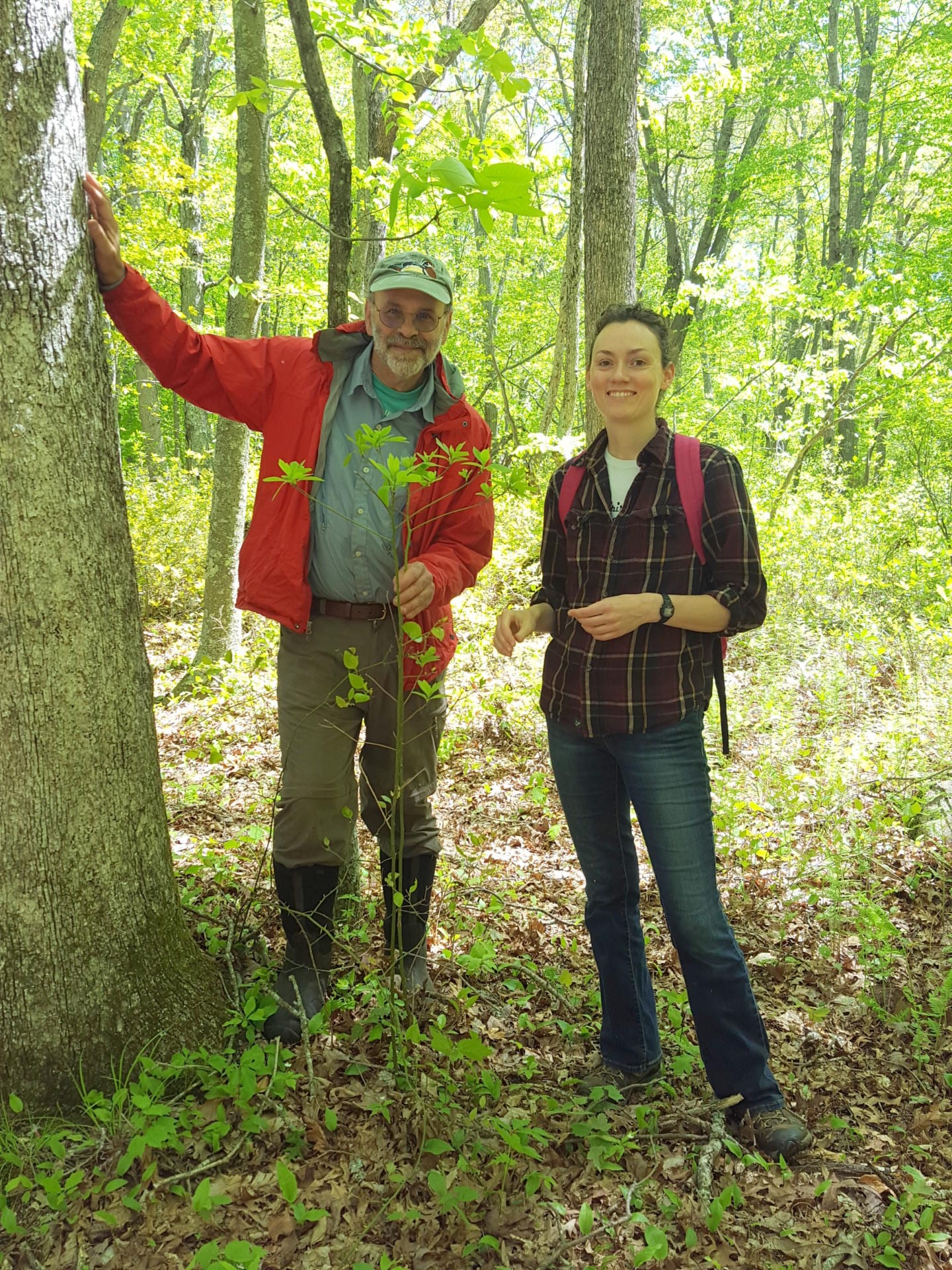 Georgia Hann is a professional plantswoman with specific interest in the ecosystems of the New England coastline and beyond. Born in Chatham, MA and raised in Mystic, CT, Georgia studied Environmental and Conservation Biology at Clark University in Worcester, MA for three years. She worked in the farming and landscaping industries in Connecticut and Rhode Island until seeking a degree in Botany at Connecticut College in New London, which she earned in 2018. She now operates a professional gardening company and works as a tree specialist. She intends to expand as a native seed-grown plant retailer fit to serve both homeowners and those carrying out habitat restoration projects.
Georgia Hann is a professional plantswoman with specific interest in the ecosystems of the New England coastline and beyond. Born in Chatham, MA and raised in Mystic, CT, Georgia studied Environmental and Conservation Biology at Clark University in Worcester, MA for three years. She worked in the farming and landscaping industries in Connecticut and Rhode Island until seeking a degree in Botany at Connecticut College in New London, which she earned in 2018. She now operates a professional gardening company and works as a tree specialist. She intends to expand as a native seed-grown plant retailer fit to serve both homeowners and those carrying out habitat restoration projects.
Russ Cohen served as the Rivers Advocate for the Massachusetts Department of Fish and Game’s Division of Ecological Restoration until his retirement in June of 2015. One of his areas of expertise was riparian vegetation. Now Russ has more time to pursue his passionate avocation, which is connecting to nature via his taste buds. In addition to leading over three dozen foraging walks and talks each year at a wide variety of venues throughout the Northeast, Russ has now taken on a role as a “Johnny Appleseed” of sorts for edible native species. He has set up a small nursery in Weston, MA where he grows/keeps plants that he propagates from seed that he collects himself and obtains from other sources, such as the Native Plant Trust. He is partnering with land trusts, cities and towns, schools and colleges, state and federal agencies, and others to locate plants from his nursery in appropriate places on their properties. Russ has initiated over two dozen such projects in the past three years. See more in his online bio: http://users.rcn.com/eatwild/bio.htm.
***
Each author appearing herein retains original copyright. Right to reproduce or disseminate all material herein, including to Columbia University Library’s CAUSEWAY Project, is otherwise reserved by ELA. Please contact ELA for permission to reprint.
Mention of products is not intended to constitute endorsement. Opinions expressed in this newsletter article do not necessarily represent those of ELA’s directors, staff, or members.

